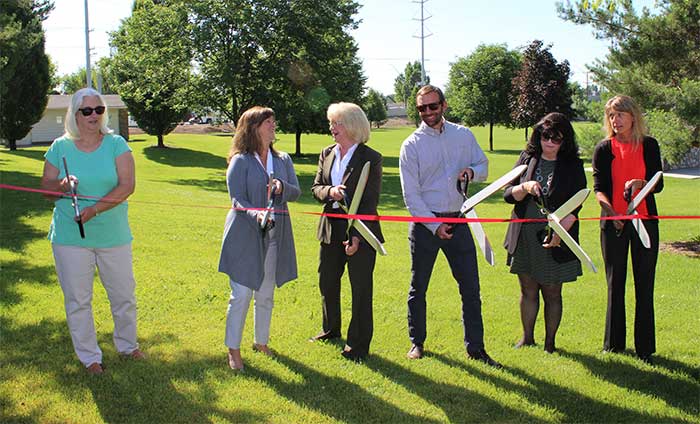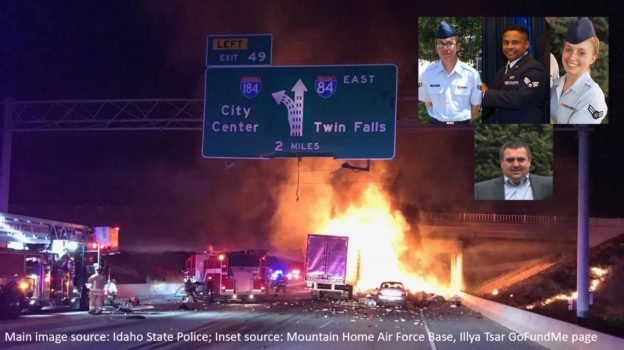By Don Kostelec
November 14, 2020
November 15, 2020 is World Day of Remembrance for Traffic Crash Victims. This important and sobering date is supported by the World Health Organization and United Nations. It dates back to 2005. In the United States, Families for Safe Streets leads the effort on behalf of traffic violence victims.
This year it brings to mind the June 2018 crash along I-84 in Boise, which killed three military members from Idaho’s Mountain Home Air Force Base and a truck driver from New York. They were:
- Senior Airman Carlos “C.J.” Johnson, 23, of Key West, Florida;
- Senior Airman Lawrence “Pit” Manlapit III, 26, of Bridgeport, Connecticut;
- Senior Airman Karlie A. Westall, 21, of Sioux Falls, South Dakota;’ and
- Illya Tsar, 42, of Rochester, New York.
The crash occurred at the Cloverdale Road overpass of I-84 as the interstate was undergoing a maintenance project. The fire that resulted from the crash damaged the overpass and necessitated its replacement. The interstate and Cloverdale Road overpass where this crash occurred is managed by the Idaho Transportation Department (ITD), while Cloverdale Road is managed by Ada County Highway District (ACHD). The agencies scrambled to rebuild the overpass, which was necessary. They did it in record time.
The insulting part to those of us fighting for traffic safety came when ITD gave itself, ACHD, and the project’s consulting firm an award for the replacement project.
The ACHD News website press release included this quote from the project manager: “This project is a great achievement for both ITD and ACHD, which would not have been possible without the collaborative effort put forth by all of those involved.”
The press release doesn’t mention the project would not have been possible without the unnecessary death of three military servicemembers and a truck driver. The ACHD press release announcing their June 2019 ribbon-cutting celebration also made no mention of the victims.

As the World Day of Remembrance website notes, this day :offers the opportunity to demonstrate the enormous scale and impact of road deaths and injuries, call for an end to the often trivial and inappropriate response to road death and injury and advocate for urgent concerted action to stop the carnage.”
The Cloverdale overpass awards and ribbon cutting constitute a trivial and inappropriate response.
Yes, they had to rebuild it it. They didn’t have to hand out awards and have a chummy ribbon cutting to celebrate it, all while four families grieve over their loss. The overpass rebuild should have been a silent exercise in agencies doing the job they had to do and nothing more. Put your head down, keep your mouth shut, and be respectful of the victims and families grieving from this tragedy.
Construction Zone Failures
Adding insult to the tragedy is that a poorly-engineering construction zone contributed to the sacrifice of the four people who that night in June 2018.
This week the National Transportation Safety Board (NTSB) published this blog post on November 9 for National Drowsy Driving Awareness week. It includes a link to NTSB’s report on this I-84 crash, followed by this statement: “In the Boise crash, the driver’s fatigue was related to inadequate sleep duration .” The post includes a link to the full crash investigation, which indicates that chalking the crash up to driver fatigue fails to tell the full story.
The NTSB investigation found that the interstate travel lanes should have never been trimmed down to only one lane of the four available. ” Despite the construction staging and traffic control plan requiring that two lanes remain open at all times during construction, lanes 1, 2, and 3 in the eastbound direction were all closed; only lane 4 (the far right lane) was open.”
This stemmed from a lack of oversight of the contractor and the Idaho Transportation Department, as NTSB stated:
- “The ITD work zone inspectors noted the lane closures in their traffic control maintenance diaries, but they did not take any action to address the fact that the lane closures exceeded those permitted by the traffic control plan or to resolve the resulting hazards associated with the traffic queue.”
- “The additional lane closure and the extension of the queue into the advance warning region resulted in inadequate warning to motorists and insufficient speed reduction for approaching traffic for this work zone.”
- “By merely noting, and not preventing, the contractor’s deviation from the traffic control plan, the ITD work zone inspectors failed to conduct the oversight for which they had been placed on the scene in the construction area.”
- “The ITD also failed by not ensuring that its inspectors fulfilled their oversight duties.”
Blaming Human Error Justifies Their Celebration
I’ve talked with friends and safety advocates here in Boise over the past year and wondered what the families of these victims think about highway agencies publicly celebrating the rebuilding of the overpass by giving themselves award and being all smiles at the ribbon cutting announcing its reopening to traffic.
The NTSB blog post continues the unfortunate trend of blaming crashes on human error, which is counter to the full depth of what their investigation found. If you’ve followed me on Twitter, you know my disdain for the erroneous claim that “94% of crashes are due to human error” and use of it by everyone from USDOT Secretary Elaine Chao, NHTSA, GHSA, State DOTs, and law enforcement.
Use of this claim ignores the fact that crashes are a causal chain of events and are heavily influenced by project engineering decisions that contribute to crashes by either inducing human error or magnifying the results of human error to make it tragic.
That’s exactly what happened in the I-84 crash, as NTSB concluded:
- “The probable cause of the Boise, Idaho, crash was the…driver’s failure to respond to the slow-moving traffic queue ahead, most likely due to performance decrements associated with fatigue.”
- “Contributing to the crash were the:
- (1) inadequate traffic control and queue management procedures employed by [the contractors], and
- (2) lack of proper oversight by the Idaho Transportation Department, which allowed an additional lane closure that was not part of the approved traffic control plan, resulting in a traffic queue that extended into the advance warning area of the work zone. ”
Less than a month after the deadly I-84 crash, the Idaho Transportation Department issued a press release on another construction zone along I-84, stating “In fact, about 94% of serious-injury crashes are caused by human error.”
That press release failed to acknowledge the role that engineering plays in creating human error or compounding the results of human error, as happened in the I-84 crash.
This is common as efforts like National Work Zone Awareness Week is full of messaging pointing the fingers at drivers for construction zone safety, all while poorly-managed construction zones persist that result in deadly consequences for motorists, other road users, and workers.
A few weeks after that press release I had a meeting with ITD planning and communications staff and handed them the NHTSA study that explicitly states the 94% claim should not be used in such a way. To ITD’s credit, I have not seen them use this claim since that meeting.
I’ll consider that a small victory in memory of those whose lives didn’t have to end so soon on that June 2018 night in Boise. It’s also a reminder that World Day of Remembrance, Vision Zero, and everything we do as traffic safety advocates is about ended the trivial and inappropriate response to these roads deaths across all modes.
ACHD and ITD should rededicate the overpass in their memory and place pictures of the victims next to the award plaques hanging in their office buildings as a reminder of those who didn’t have to die for that plaque.

